Aspergillosis refers to infection by any of the Aspergillus species. Infection can be limited to the lungs (pulmonary) or spread throughout the body (disseminated aspergillosis) in more severe cases. The main disease-causing species are: Aspergillus fumigatus, Aspergillus flavus, Aspergillus terreus and Aspergillus niger.
For more information please see the Aspergillus & Aspergillosis website.

Factsheets
Aspergillus fumigatus
| NAMES Aspergillus fumigatus [ Teleomorph = Neosartorya fumigata ] |
| NATURAL HABITAT Very common distribution, found everywhere from grasslands to mountainous terrain to high temperature habitats. Highly aerobic fungus and therefore found in most oxygenated environments. More common in cultivated fields compared to uncultivated fields. High counts in garden soils. Also found in compost, bird droppings, tobacco and stored foods such as potatoes. |
| GEOGRAPHY Worldwide |
| FREQUENCY It is the most common airborne fungus due to growth in a wide range of temperatures. |
| DISEASES A. fumigatus is associated with: – Chronic pulmonary aspergillosis (CPA) and aspergilloma – Asthma exacerbation and severe asthma with fungal sensitisation (SAFS) – Allergic bronchopulmonary aspergillosis (ABPA) – Chronic invasive and granulomatous sinusitis – Fungus ball of the sinus – Aspergillus bronchitis and invasive Aspergillus tracheobronchitis – Invasive (pulmonary) aspergillosis (IA/IPA) – Disseminated aspergillosis |
| CULTURE Powdery surface and dark green in colour with a white border. Colonies turn grey with age and the reverse is white to tan. Biosafety level 2 |
| ANTIFUNGAL RESISTANCE Some emerging strains are resistant to itraconazole, with cross-resistance to voriconazole and posaconazole. Polyene resistance unheard of. Some rare acquired resistance to echinocandin drugs. |
| INDUSTRIAL USES None, although several heat resistant enzymes (phytase, pectinase, cellulase) identified with potential for industrial use. |
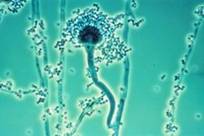
A. fumigatus head surrounded by hyphae and conidiospores 
A. fumigatus grown from a woodland source for 7 days on Czapek yeast extract agar (photo by Dr. David Midgley) 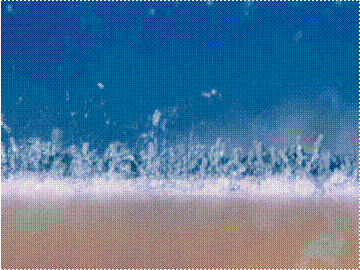
Appearance of multiple fruiting heads of A. fumigatus on agar with long conidial heads

Aspergillus niger
| NAMES Aspergillus niger (also applies to closely-related and cryptic species, such as A. awamori and A. tubingensis) [ Teleomorph = Sterigmatocystis nigra ] |
| NATURAL HABITAT Primarily soil, but has been isolated from various habitats. |
| GEOGRAPHY Worldwide |
| FREQUENCY Common in otomycosis (fungal ear infections). Occasionally found in aspergillomas (diabetics) and invasive pulmonary aspergillosis but this species rarely disseminates through the body. |
| DISEASES Aspergillosis refers to infection by any of the Aspergillus species. Infection can be limited to the lungs (pulmonary) or spread throughout the body (disseminated Aspergillosis) in more severe cases. Aspergillus niger is most often associated with: – Otomycosis – Chronic pulmonary aspergillosis (CPA) and aspergilloma – Asthma exacerbation and severe asthma with fungal sensitisation (SAFS) – Allergic bronchopulmonary aspergillosis (ABPA) – Aspergillus bronchitis and invasive tracheobronchitis – Invasive (pulmonary) aspergillosis (IPA/IA) – Disseminated aspergillosis |
| CULTURE Cottony appearance; initially white to yellow and then turning black. Made up of felt-like conidiophores. Reverse is white to yellow. In microscopy, the conidial heads are radiate with conidiogenous cells biseriate. Conidia brown. Biosafety level 1 |
| ANTIFUNGAL RESISTANCE One study showed itraconazole resistance in 33% of isolates (Howard et al, 2011). Cross-resistance has been noted but is unusual. |
| INDUSTRIAL USES Citric and gluconic acids are produced industrially through A. niger. Some useful enzymes are produced during fermentation including glucoamylase (used for the manufacturing of corn syrup) and pectinases (for wine and cider clarification). A. niger is used for the production of glucose oxidase, an enzyme used in glucose biosensors. |
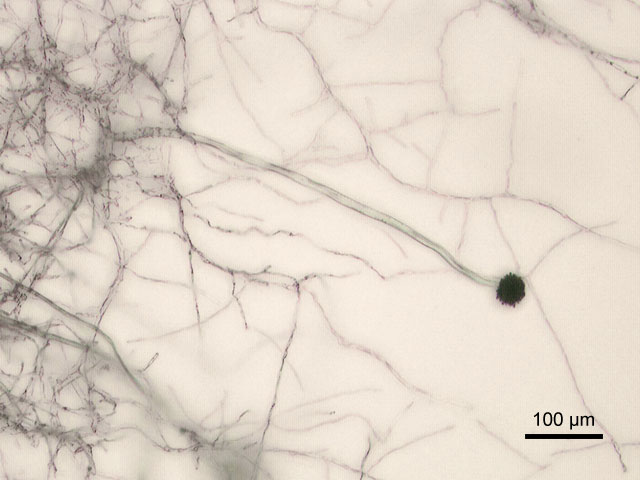
A. niger grown on Sabouraud agar 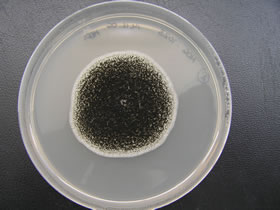
A. niger on alt extract agar 
Microscopical appearance of A. niger

Aspergillus flavus
| NAMES Aspergillus flavus [ no teleomorph ] |
| NATURAL HABITAT Common contaminant of food and soil. |
| GEOGRAPHY Worldwide |
| FREQUENCY Second most common cause of aspergillosis after Aspergillus fumigatus and increasingly being isolated. More common than A. fumigatus in air for unknown reasons. |
| DISEASES Aspergillus flavus is most often associated with: – Chronic cavitary pulmonary aspergillosis (CPA) – Allergic bronchopulmonary aspergillosis (ABPA) – Allergic fungal sinusitis and sinus aspergilloma – Keratitis and endophthalmitis – Cutaneous and wound infections – Endocarditis, pericarditis and CNS infections – Osteoarticular infections – Urinary tract infections |
| CULTURE Velvet-like; yellow to green or brown mould with a gold to red-brown reverse. In microscopy, the conidial heads are radiate. Conidiogenous cells are uni- or biseriate and conidia echinulate. Biosafety level 2 |
| ANTIFUNGAL RESISTANCE Acquired amphotericin B resistance becoming increasingly prevalent. Mostly susceptible to echinocandins and triazole antifungals but some resistance has been noted; however, the overall percentage of isolates resistant to these drugs remains low. |
| INDUSTRIAL USES Model organism for aflatoxin (potent carcinogen found in food) and other mycotoxins. Biocontrol organism for crops: genetic manipulation of an A. flavus strain in which the aflatoxin pathway has been knocked out and now spread on crops, successfully competing with natural strains that do produce aflatoxin. Very closely related to Aspergillus oryzae which is extensively used in Asia for the making of soy sauce, miso and other fermented foods. |

Typical appearance of the conidial head of A. flavus stained with lactophenol
cotton blue, with the green appearance of the spores apparent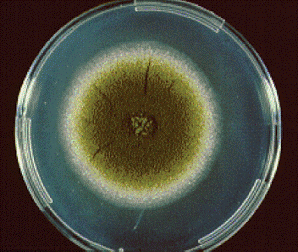
A. flavus colony green colouration on Sabouraud dextrose agar 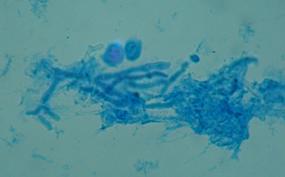
A. flavus from a patient with fungal keratitis,
stained with lactophenol cotton blue (Dr Philip Thomas)

Aspergillus terreus
| NAMES Aspergillus terreus (formerly Sterigmatomyces hortai) |
| NATURAL HABITAT Found in a wide variety of habitats; soil, compost, dust. |
| GEOGRAPHY Worldwide |
| FREQUENCY Less common than A. fumigatus and some other common Aspergillus species as A. flavus or A. niger; however, it remains one of the more commonly encountered, opportunistic moulds causing aspergillosis. It is more common in certain geographical locations . |
| DISEASES A. terreus can cause: – Invasive pulmonary aspergillosis (IA/IPA) – Allergic bronchopulmonary aspergillosis (ABPA) – Aspergillus bronchitis and invasive tracheobronchitis – Disseminated aspergillosis |
| CULTURE Appears brown in all culture media. In Czapek dox agar the appearance on the reverse is cinnamon/sandy. Microscopically, the conidial heads are densely columnar and the vesicles are subspherical with conidiogenous cells biseriate. Conidiophore stalks are smooth walled. Conidia are smooth-walled. Biosafety level 2 |
| ANTIFUNGAL RESISTANCE Intrinsic resistance to amphotericin B, with rare exceptions. Triazole resistance has been acquired rarely. |
| INDUSTRIAL USES Original source of lovastatin. It is also used to produce important organic acids, such as itaconic acid and cis-aconitic acid as well as commercially important enzymes such as xylanase. |
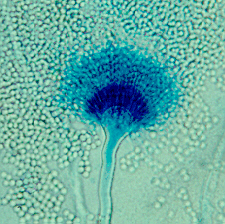
A. terreus conidial head 
A. terreus grown on Czapek dox agar
